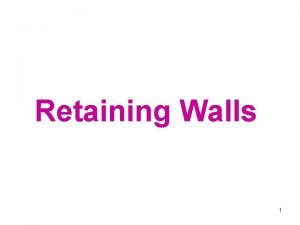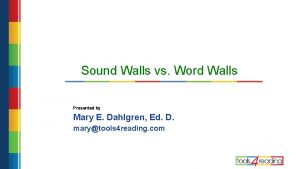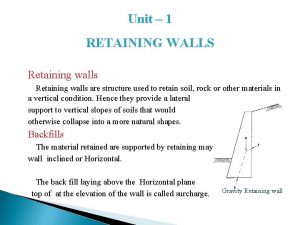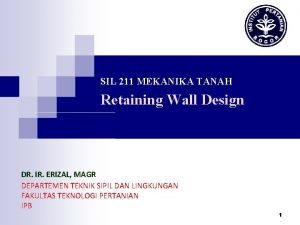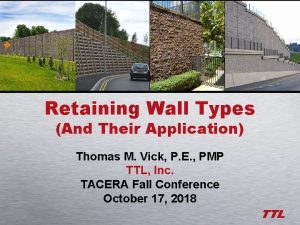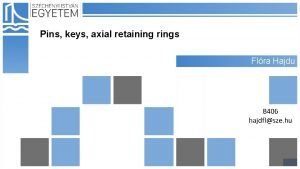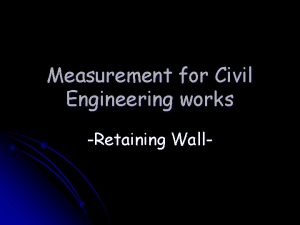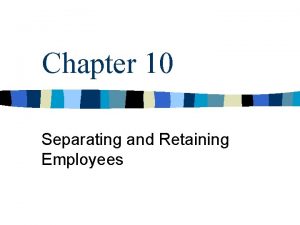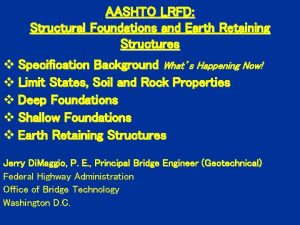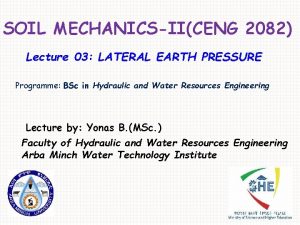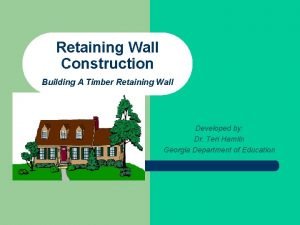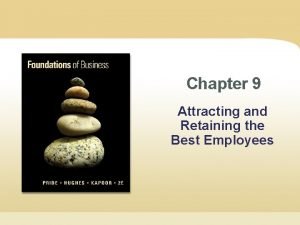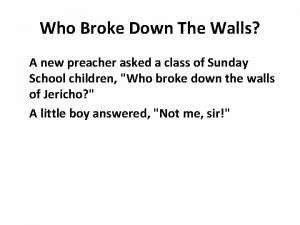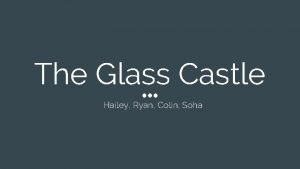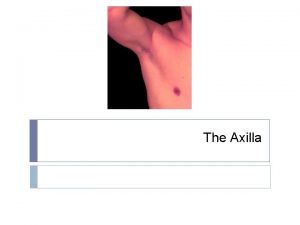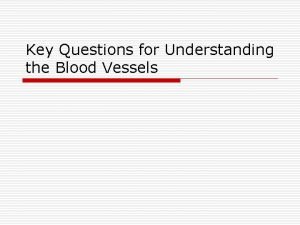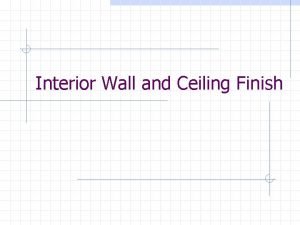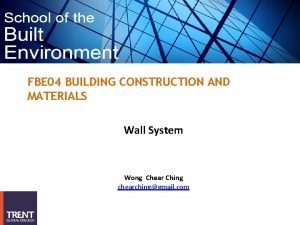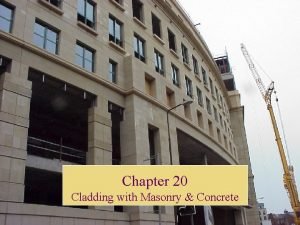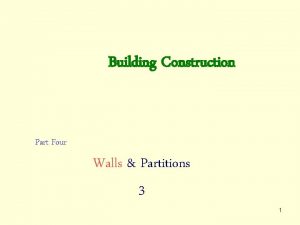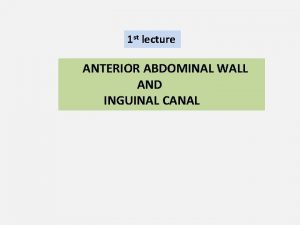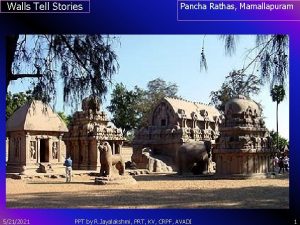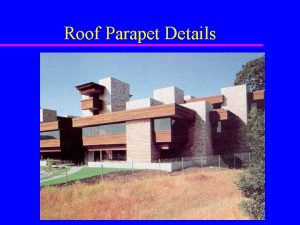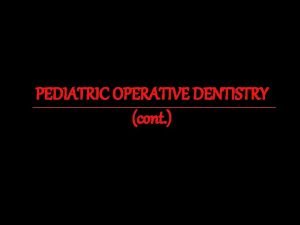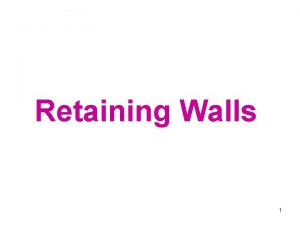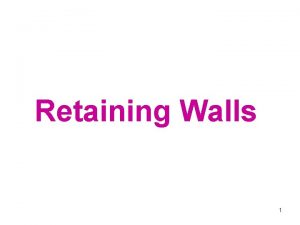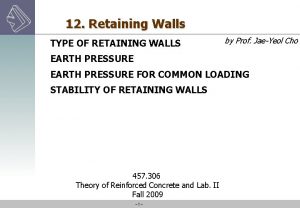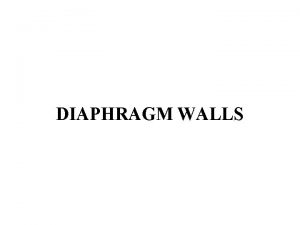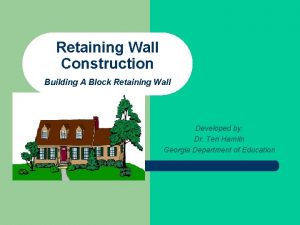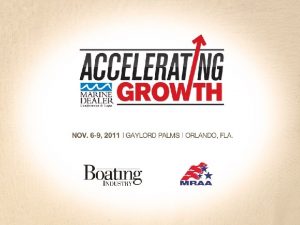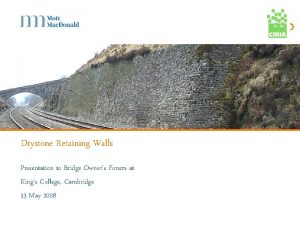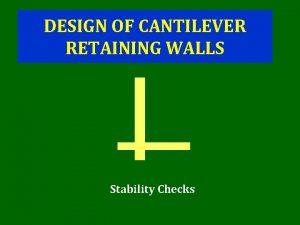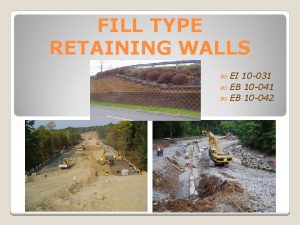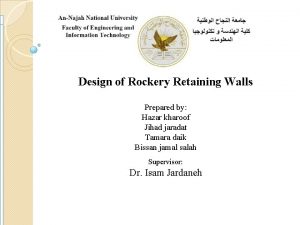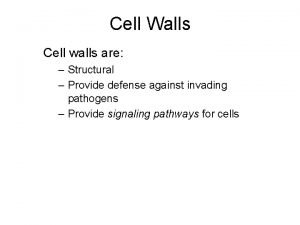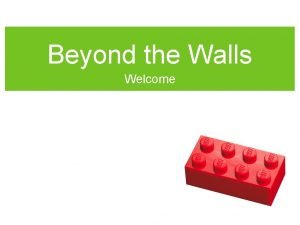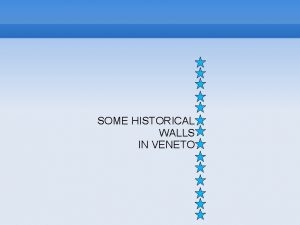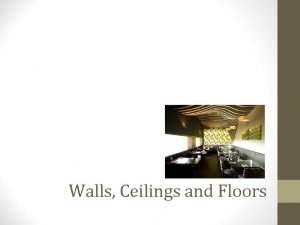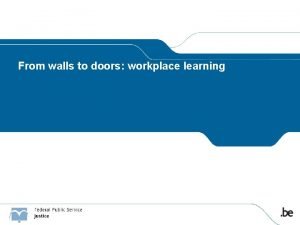Unit 1 RETAINING WALLS Retaining walls are structure


















![Depth of foundation � To fix the height of retaining wall [H] � H= Depth of foundation � To fix the height of retaining wall [H] � H=](https://slidetodoc.com/presentation_image_h2/f600243089a9c2876823ab80645c74eb/image-19.jpg)


















- Slides: 37

Unit – 1 RETAINING WALLS Retaining walls are structure used to retain soil, rock or other materials in a vertical condition. Hence they provide a lateral support to vertical slopes of soils that would otherwise collapse into a more natural shapes. Backfills The material retained are supported by retaining may wall inclined or Horizontal. The back fill laying above the Horizontal plane top of at the elevation of the wall is called surcharge. Gravity Retaining wall

Retaining walls

Cantilever retaining wall with shear key

Classification of Retaining walls • Gravity wall-Masonry or Plain concrete • Cantilever retaining wall-RCC (Inverted T and L) • Counterfort retaining wall-RCC • Buttress wall-RCC

Classification of Retaining walls Backfill Gravity RW Backfill L-Shaped RW T-Shaped RW Backfill Counterfort RW Buttress RW

Earth Pressure (P) Earth pressure is the pressure exerted by the retaining material on the retaining wall. This pressure tends to deflect the wall outward. GL Types of earth pressure : Active earth pressure or earth pressure (Pa) and Passive earth pressure (Pp). Active earth pressure tends to deflect the wall away from the backfill. Pa Variation of Earth pressure

Earth pressure depends on type of backfill, the height of wall and the soil conditions Soil conditions: The different soil conditions are • • • Dry leveled back fill Moist leveled backfill Submerged leveled backfill Leveled backfill with uniform surcharge Backfill with sloping surface

Analysis for dry back fills Maximum pressure at any height, p=ka�h Total pressure at any height from top, pa=1/2[ka�h]h = [ka�h 2]/2 h H Bending moment at any height M=paxh/3= [ka�h 3]/6 �Total pressure, Pa= [ka�H 2]/2 Total Bending moment at bottom, M = [ka�H 3]/6 Pa M ka H

Where, ka= Coefficient of active earth pressure = (1 -sin�)/(1+sin�)=tan 2� = 1/kp, coefficient of passive earth pressure �= Angle of internal friction or angle of repose �=Unit weigh or density of backfill If �= 30�, ka=1/3 and kp=3. Thus ka is 9 times kp

Backfill with sloping surface pa= ka H at the bottom and is parallel to inclined surface of backfill ka= Where =Angle of surcharge Total pressure at bottom =Pa= ka H 2/2

Counterfort Retaining wall CF • • • When H exceeds about 6 m, Stem and heel thickness is more More bending and more steel Cantilever-T type-Uneconomical Counterforts-Trapezoidal section 1. 5 m -3 m c/c Stem Base Slab CRW 11

Parts of CRW • Same as that of Cantilever Retaining wall Plus Counterfort Stem Toe Counterforts Heel Base slab Cross section Plan 12

Design of Stem • The stem acts as a continuous slab • Soil pressure acts as the load on the slab. • Earth pressure varies linearly over the height • The slab deflects away from the earth face between the counterforts • The bending moment in the stem is maximum at the base and reduces towards top. • But the thickness of the wall is kept constant and only the area of steel is reduced. BF p=Kaγh 13

Design of Toe Slab � � � The base width=b =0. 6 H to 0. 7 H The projection=1/3 to 1/4 of base width. The toe slab is subjected to an upward soil reaction and is designed as a cantilever slab fixed at the front face of the stem. Reinforcement is provided on earth face along the length of the toe slab. In case the toe slab projection is large i. e. > b/3, front counterforts are provided above the toe slab and the slab is designed as a continuous horizontal slab spanning between the front counterforts. H b 14

Design of Heel Slab The heel slab is designed as a continuous slab spanning over the counterforts and is subjected to downward forces due to weight of soil plus self weight of slab and an upward force due to soil reaction. Maximum +ve B. M= pl 2/16 (mid-way between counterforts) And Maximum -ve B. M= pl 2/12 (occurring at counterforts) BF 15

Design of Counterforts • • • The counterforts are subjected to outward reaction from the stem. This produces tension along the outer sloping face of the counterforts. The inner face supporting the stem is in compression. Thus counterforts are designed as a T-beam of varying depth. The main steel provided along the sloping face shall be anchored properly at both ends. The depth of the counterfort is measured perpendicular to the sloping side. C T d 16

Behaviour of Counterfort RW -M Important points +M • Loads on Wall COUNTERFORT • Deflected shape • Nature of BMs STEM • Position of steel -M • Counterfort details HEEL SLAB TOE +M 17

Cantilever RW design Design a cantilever retaining wall (T type) to retain earth for a height of 4 m. The backfill is horizontal. The density of soil is 18 k. N/m 3. Safe bearing capacity of soil is 200 k. N/m 2. Take the co -efficient of friction between concrete and soil as 0. 6. The angle of repose is 30°. Use M 20 concrete and Fe 415 steel. Solution Data: h' = 4 m, SBC= 200 k. N/m 2, = 18 k. N/m 3, μ=0. 6, φ=30° 18
![Depth of foundation To fix the height of retaining wall H H Depth of foundation � To fix the height of retaining wall [H] � H=](https://slidetodoc.com/presentation_image_h2/f600243089a9c2876823ab80645c74eb/image-19.jpg)
Depth of foundation � To fix the height of retaining wall [H] � H= h' +Df � Depth � � Df �= of foundation = 1. 23 m say 1. 2 m , � Therefore H= 5. 2 m 200 h 1 h H Df b 19

Proportioning of wall � � � � Thickness of base slab=(1/10 to 1/14)H 0. 52 m to 0. 43 m, say 450 mm 200 Width of base slab=b = (0. 5 to 0. 6) H 2. 6 m to 3. 12 m say 3 m Toe projection= pj= (1/3 to ¼)H 1 m to 0. 75 m say 0. 75 m Provide 450 mm thickness for the stem at the base and 200 mm at the top H=5200 mm tp= 750 mm 450 b= 3000 mm 20

Design of stem Ph= ½ x 1/3 x 18 x 4. 752=67. 68 k. N M = Ph h/3 = 0. 333 x 18 x 4. 753/6 = 107. 1 k. N-m Mu= 1. 5 x M = 160. 6 k. N-m Taking 1 m length of wall, Mu/bd 2= 1. 004 < 2. 76, URS (Here d=450 - eff. Cover=450 -50=400 mm) M To find steel Df Pt=0. 295% <0. 96% ka h Ast= 0. 295 x 1000 x 400/100 = 1180 mm 2 #12 @ 90 < 300 mm and 3 d ok Or Mu = Ast provided= 1266 mm 2 [0. 32%] [ka H 3]/6 h Pa 21

Curtailment of bars-Stem Curtail 50% steel from top (h 1/h 2)2 = 50%/100%=½ (h 1/4. 75)2 = ½, h 1 = 3. 36 m Actual point of cutoff = 3. 36 -Ld=3. 36 -47 φbar = A /2 3. 36 -0. 564 = 2. 74 m from top. Spacing of bars = 180 mm A c/c < 300 mm and 3 d ok Dist. from top h 1 h 2 st st Every alternate bar cut h 1 c Ldt h 2 Ast/2 Ast Provid ed 22

Development length (Stem steel) Ld=47 φbar =47 x 12 = 564 mm Secondary steel for stem at front 0. 12% GA = 0. 12 x 450 x 1000/100 = 540 mm 2 #10 @ 140 < 450 mm and 5 d ok Distribution steel = 0. 12% GA = 0. 12 x 450 x 1000/100 = 540 mm 2 #10 @ 140 < 450 mm and 5 d ok 200 H=5200 mm tp= 750 mm 450 b= 3000 mm 23

Check for shear Max. SF at Junction, xx = Ph=67. 68 k. N Ultimate SF= Vu=1. 5 x 67. 68 = 101. 52 k. N Nominal shear stress =ζv=Vu/bd = 101. 52 x 1000 / 1000 x 400 = 0. 25 MPa To find ζc: 100 Ast/bd = 0. 32%, From IS: 456 -2000, ζc= 0. 38 MPa ζv < ζc, Hence safe in shear. 200 H=5200 mm x x b= 3000 mm 24

Stability analysis Load Magnitude, k. N Distance from A, m Stem W 1 0. 2 x 4. 75 x 1 x 25 = 23. 75 1. 1 ½ x 0. 25 x 4. 75 x 1 x 25 = 14. 84 B. slab W 3 3. 0 x 0. 45 x 1 x 25=33. 75 Back fill, 1. 8 x 4. 75 x 1 x 18 W 4 = 153. 9 Total ΣW= 226. 24 Earth Pre. PH =0. 333 x 18 x 5. 22/2 =PH Stem W 2 0. 75 + 2/3 x 0. 25 =0. 316 1. 5 2. 1 BM about A k. N-m 26. 13 13. 60 50. 63 323. 20 ΣMR=413. 55 H/3 =5. 2/3 MO=140. 05 25

x 1 h x 2 W 4 W 1 H W W 2 Pa R W 3 T x e b/6 b 0. 75 m 0. 45 m Pmax 120. 6 k. N/m 2 H/3 b/2 1. 8 m 24. 1 22. 6 Pmin. 30. 16 k. N/m 2 97. 99 Forces acting on the wall and the pressure below the wall Pressure below the Retaining Wall 26

Stability checks � � � � � Check for overturning FOS = ΣMR/ MO= 2. 94 >1. 55 safe Check for Sliding FOS = μ ΣW/ PH= 2. 94 >1. 55 safe Check for subsidence X=ΣM/ ΣW= 1. 20 m > b/3 and e= b/2 –x = 3/2 – 1. 2 = 0. 3 m < b/6 Pressure below the base slab PMax=120. 66 k. N/m 2 < SBC, safe PMin = 30. 16 k. N/m 2 > zero, No tension or separation, safe 27

0. 75 m 0. 45 m 1. 8 m 30. 16 k. N/m 2 120. 6 k. N/m 2 22. 6 97. 99 24. 1 Pressure below the Retaining Wall Load Magnitude, k. N Distance from C, m BM, MC, k. N-m Backfill 153. 9 0. 9 138. 51 Heel slab 0. 45 x 1. 8 x 25 = 27. 25 0. 9 18. 23 Pressure dist. rectangle 30. 16 x 1. 8 =54. 29 0. 9 -48. 86 Pressure dist. Triangle ½ x 24. 1 x 1. 8=21. 69 1/3 x 1. 8 -13. 01 Total ΣMC=94. 86 Total Load Desig n of heel slab 28

� Design of heel slab-Contd. , Mu= 1. 5 x 94. 86 =142. 3 k. Nm Mu/bd 2= 0. 89 < 2. 76, URS Pt=0. 264% < 0. 96% Ast= 0. 264 x 1000 x 400/100 =1056 mm 2 200 H=5200 mm x #16@ 190 < 300 mm and 3 d ok Ast provided= 1058 mm [0. 27%] x b= 3000 mm OR Mu=0. 87 fy Ast[d - (fy. Ast/fckb)] 29

Design of heel slab -Contd. , 200 Development length: Ld=47 φbar =47 x 16 = 752 mm Distribution steel Same, #10 @ 140 < 450 mm and 5 d ok H=5200 mm x Ldt=752 x 30

Design of heel slab-Contd. , Check for shear at junction (Tension) � Maximum shear =V=105. 17 k. N, � VU, max= 157. 76 k. N, � Nominal shear stress =ζv=Vu/bd � = 101. 52 x 1000 / 1000 x 400 = 0. 39 MPa 200 � To find ζc: 100 Ast/bd = 0. 27%, � From IS: 456 -2000, ζc= 0. 37 MPa � ζv slightly greater than ζc, � Hence slightly unsafe in shear. � x x 31

Design of toe slab Load Toe slab Distance Magnitude, k. N from C, m 0. 75 x 0. 45 x 25 = Pressure distribution, 97. 99 x 0. 75 rectangle 0. 75/2 -3. 164 0. 75/2 27. 60 Pressure distribution, ½ x 22. 6 x 1. 0. 75 2/3 x 1=0. 75 triangle Total Load at junction Bending moment, MC, k. N-m Total BM at junction 4. 24 ΣM=28. 67 32

� Design of toe slab Mu= 1. 5 x 28. 67 =43 k. N-m Mu/bd 2= 0. 27< 2. 76, URS 200 Pt=0. 085% Very small, provide 0. 12%GA Ast= 540 mm 2 #10 @ 140 < 300 mm and 3 d ok Development length: Ld=47 φbar =47 x 10 = 470 mm Ldt 33

Design of toe slab-Contd. , Check for shear: at d from junction (at xx as wall is in compression) 200 Net shear force at the section V= (120. 6+110. 04)/2 x 0. 35 0. 45 x 0. 35 x 25=75. 45 k. N VU, max=75. 45 x 1. 5=113. 18 k. N ζv =113. 17 x 1000/(1000 x 400)=0. 28 MPa x d x Ldt pt≤ 0. 25%, From IS: 456 -2000, ζc= 0. 37 MPa ζv < ζc, Hence safe in shear. 34

Other deatails � Construction joint �A key 200 mm wide x 50 mm deep � with nominal steel � #10 @ 250, 600 mm length in two rows � Drainage � 100 mm dia. pipes as weep holes at 3 m c/c at bottom � Also provide 200 mm gravel blanket at the back of the stem for back drain. 35

Drawing and detailing #12 @ 180 #10 @ 140 #12 @ 90 #16 @ 190 #10 @ 140 C/S OF WALL L/S ELEVATION OF WALL

Drawing and detailing BASE SLAB DETAILS BOTTOM STEEL PLAN OF BASE SLAB TOP STEEL 37
 Mikael ferm
Mikael ferm Length of retaining wall
Length of retaining wall Analysis usbrown wall
Analysis usbrown wall Sound wall vs word wall
Sound wall vs word wall Unit 6 review questions
Unit 6 review questions Curtailment of bars in retaining wall
Curtailment of bars in retaining wall Expansion joint in retaining wall
Expansion joint in retaining wall Retaining wall meaning
Retaining wall meaning Retaining millennial physicians
Retaining millennial physicians 406 woodruff key dimensions
406 woodruff key dimensions Earth retaining system
Earth retaining system Separating and retaining employees
Separating and retaining employees Recruiting and retaining capable employees
Recruiting and retaining capable employees Foundations and earth retaining structures
Foundations and earth retaining structures Surcharge load on retaining wall
Surcharge load on retaining wall Timber retaining wall construction
Timber retaining wall construction Comprehensive approach to retaining employees
Comprehensive approach to retaining employees Attracting and retaining the best employees
Attracting and retaining the best employees Comprehensive approach to retaining employees
Comprehensive approach to retaining employees Retaining members in an organization
Retaining members in an organization Who broke the wall of jericho
Who broke the wall of jericho Jeannette walls welch house
Jeannette walls welch house Axillary lymph nodes
Axillary lymph nodes Sound of heaven touching earth
Sound of heaven touching earth School wide data walls
School wide data walls These vessels have thicker walls and a heavier tunica media
These vessels have thicker walls and a heavier tunica media Interior wall finish
Interior wall finish Functional requirement of wall
Functional requirement of wall Septal mi ekg
Septal mi ekg Data walls for teachers
Data walls for teachers Masonry veneer curtain walls
Masonry veneer curtain walls Four walls construction
Four walls construction Abdominal surgery incision
Abdominal surgery incision Walls tell stories class 5 ppt
Walls tell stories class 5 ppt Parapet wall detailing
Parapet wall detailing In marble walls as white as milk
In marble walls as white as milk Isthmus class 2
Isthmus class 2 Fungal cell characteristics
Fungal cell characteristics

